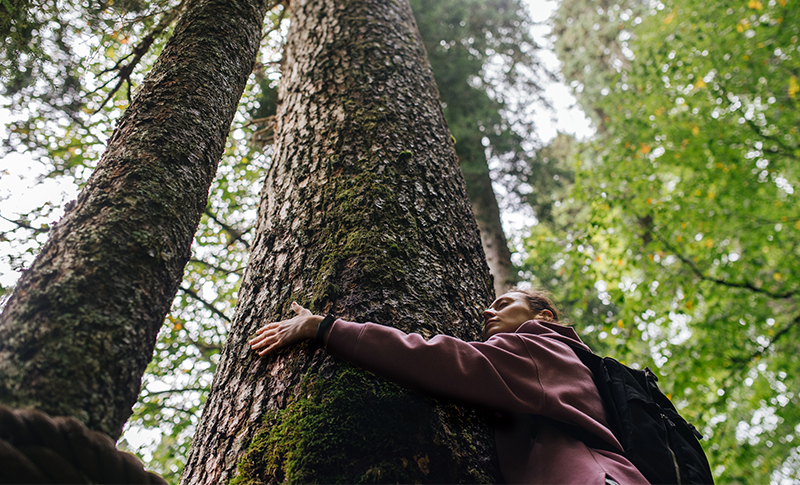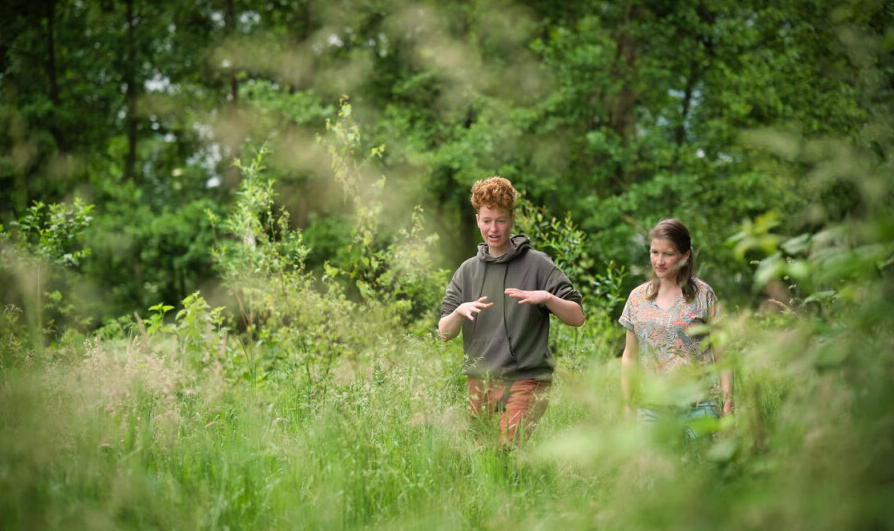Text Rianne Lindhout
Nature can fill a spiritual void and the tourism industry can capitalize on that, claims an article in Annals of Tourism Research co-authored by assistant professor Forest and Nature Policy Bas Verschuuren.
Verschuuren has been researching people’s spiritual connection with nature for years. ‘This new research shows that spirituality is a factor in visits to protected areas and that the tourism industry can enhance such experiences.’ And not just in China, which the article is about, but in the Netherlands as well: ‘Twenty years ago it was not common, but here too people now pay visits to extraordinary old trees, do yoga in natural environments or take part in a shamanic workshop.’ Verschuuren: ‘The spiritual dimension that we in the West neglected for a long time is very deeply ingrained in us and plays an important role in our relationship with nature. If tourism makes use of this, spiritual experiences can make visitors and local managers realize the importance of nature conservation.’ And that is urgently needed: ‘In China’s Yunnan province, 90 per cent of the sacred forests have been turned into rubber plantations. The remnants have become the starting point for forest and biodiversity restoration in the region.’
We still have a lot to learn from indigenous people and the role of spirituality
But there is a risky side to spiritual tourism, admits Verschuuren. ‘We should not for example let an area where hermits live peacefully in caves get overrun with tourists.’ He previously presented international guidelines to help nature managers recognize the cultural and spiritual significance of nature and put that at the heart of the way we protect it. Two years later, those guidelines have been put to good use. ‘A ministry in Brazil has already laid on more than 60 workshops and courses for policymakers and nature managers. This summer, we ourselves are hosting a workshop for the FAO, the UN food and agriculture organization, on how to use cultural and spiritual values in managing food systems in mountain areas.’
Researching spirituality
That motivates Verschuuren, in spite of how bad things are looking for nature worldwide. ‘Within our Forest and Nature Conservation Policy chair group, we specifically focus on human-nature relations and contribute to social change. Interest is growing, both among the general public and among scientists and students. In collaboration with the Nature College Foundation, we now teach courses such as Wild Perspectives and Anthropology of Basic Nature Skills, which focus on relational learning in and from nature.
Twenty years ago it was not common, but even here people now pay visits to extraordinary old trees
And our new associate professor of Human-Nature Relations in the Anthropocene, Maria Tengö, has an important role as a driving force and networker within science, with a focus on positive relationships in the co-production of knowledge.’ These developments support the research on spirituality in human-nature relations, says Verschuuren. Research by PhD student Cathrien de Pater, for instance, shows that it is possible to clarify the element of spirituality in relation to forests, for which she developed a conceptual framework similar to Shaohua Wang’s pyramid (see inset). ‘This type of research is important because it facilitates the analysis and interpretation of spirituality in forest management plans and forest policy.’ De Pater and Verschuuren and other researchers recently published their analysis of the spiritual aspects of 10 Canadian and 10 Dutch forest management plans in Forest Policy and Economics. Interestingly, spirituality is not only relevant for forest management in areas where indigenous people live, but also here in the Netherlands.
Spiritual policy
Traditional and new knowledge on spirituality can enrich debates on biodiversity loss and climate change, says Verschuuren. In policy circles, there is a growing interest in the role of spirituality in nature management. ‘We still have a lot to learn from indigenous people and the role of spirituality in their connection with nature. Many indigenous people are animists to whom places, animals and plants have a unique spiritual essence. That influences how they learn from and interact with their environment.
At the UN Biodiversity Summit late last year in Canada, it was agreed that 30 per cent of all land and water should be protected nature by 2030 and that indigenous people have a key role to play in this. However, thanks to the EU and others, no mandatory legal protection of indigenous habitats was agreed on.’ Instead, the emphasis was on new protected areas, which are usually less effective. Indigenous habitats alone account for almost 30 per cent of the earth’s surface and by some estimates contain approximately 80 per cent of the biodiversity, but they are subjected to deforestation, mining, infrastructural development and agricultural expansion. ‘So it is very doubtful whether the recognition of indigenous people and their spirituality will suffice for dealing with this.’
Spiritual pyramid
The research that got into Annals of Tourism Research, an academic journal on tourism studies, in late February, is by PhD student Shaohua Wang of the University of Girona (Spain), who was supervised by Verschuuren and others. It concerns a pyramid-shaped model of spiritual tourism that Wang tested in interviews with visitors to Chinese nature reserves, policymakers and tourism professionals.
At the bottom of the pyramid are people who ‘simply visit’ a protected nature reserve. Just above them come people who have an unexpected first spiritual experience during their visit. For example, one person reported that hearing stories about people from the past made them think more seriously.
At the next level are the people who visit an area with the express aim of having a spiritual experience ‑ such as a sense of ‘flow’, a feeling of being one with nature, or a chance to think about who you really are and what you want in life. One interviewee said: ‘It seems that visiting such places can cleanse our souls.’ At the top of the pyramid are people who visit nature areas in order to participate in spiritual or religious activities.

 Photo Shutterstock
Photo Shutterstock 

